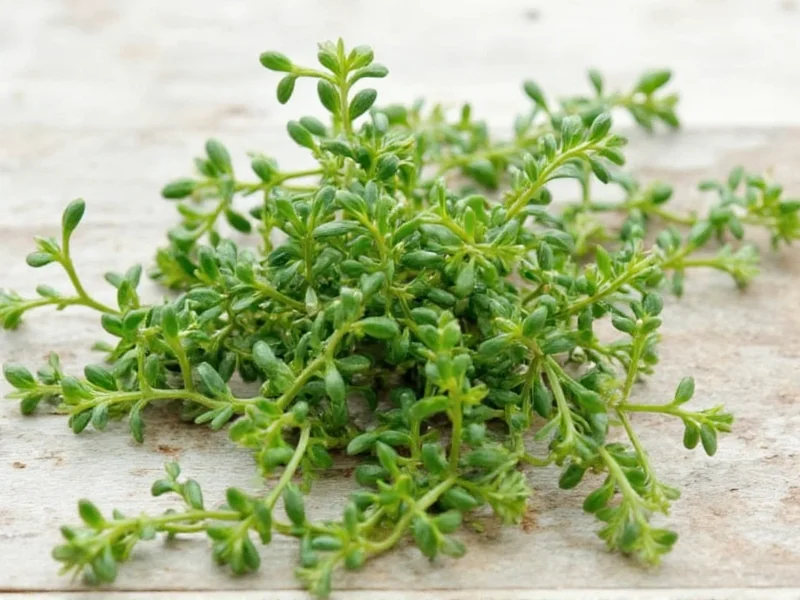When your recipe calls for thyme but you're out of this versatile herb, knowing reliable alternatives can save your dish. Thyme's distinctive earthy, slightly minty flavor enhances countless recipes from roasted meats to stews and sauces. Whether you're dealing with an empty spice rack, dietary restrictions, or simply want to experiment with different flavor profiles, understanding proper thyme substitutes ensures your cooking remains successful.
Understanding Thyme's Flavor Profile
Before exploring alternatives for thyme, it's essential to understand what makes thyme unique. This perennial herb offers a complex flavor profile—earthy with subtle notes of mint, lemon, and pepper. Common varieties include English thyme (most versatile), lemon thyme (citrus-forward), and French thyme (more robust). When seeking thyme replacement options, consider which aspect of thyme's flavor you want to replicate in your specific dish.
Top Fresh Thyme Substitutes
When substituting fresh thyme, maintain the same volume measurement for most alternatives unless otherwise noted:
| Substitute | Flavor Profile | Best Used In | Substitution Ratio |
|---|---|---|---|
| Rosemary | Pine-like, robust, slightly peppery | Roasted meats, potatoes, hearty stews | 1:1 (use slightly less for delicate dishes) |
| Oregano | Earthy, slightly bitter, warm | Tomato-based sauces, Italian dishes, grilled vegetables | 1:1 (dried) or 2:1 (fresh oregano to thyme) |
| Marjoram | Sweeter, milder cousin of oregano | Egg dishes, light sauces, poultry, vegetable dishes | 1:1 |
| Savory | Peppery, thyme-like with pine notes | Bean dishes, lentil soups, stuffing | 1:1 |
| Sage | Earthy, slightly peppery, camphor notes | Thanksgiving dishes, pork recipes, butter sauces | Use half the amount of thyme called for |
Dried Thyme Replacement Options
Dried herbs generally have more concentrated flavors than fresh. When looking for dried thyme alternatives:
- Dried oregano works well in tomato-based dishes and Mediterranean recipes—use ¾ teaspoon dried oregano per 1 teaspoon dried thyme
- Dried marjoram provides a milder alternative suitable for delicate dishes—substitute at a 1:1 ratio
- Herbes de Provence (which often contains thyme) can replace thyme in French recipes—use 1½ teaspoons blend per 1 teaspoon thyme
- Italian seasoning (typically contains thyme, oregano, and basil) works in pasta sauces—use 1:1 ratio
Specialized Thyme Substitutes by Cuisine
Different culinary traditions offer unique alternatives for thyme that maintain authentic flavor profiles:
Mediterranean Dishes
For Greek or Italian recipes calling for thyme, oregano makes the best thyme substitute for Italian dishes. Use slightly less oregano than thyme called for, as its flavor is more assertive. In tomato-based sauces, the combination of oregano and a pinch of basil creates an excellent thyme alternative for pasta sauces.
French Cuisine
When preparing French recipes, consider using a combination of marjoram and a small amount of tarragon as a thyme replacement in French dishes. The marjoram provides the floral notes while tarragon adds complexity. For coq au vin or beef bourguignon, a bay leaf combined with parsley stems works as an effective thyme substitute in stew recipes.
British and American Dishes
For roast chicken thyme alternatives, rosemary provides the most similar earthy profile. When making Thanksgiving stuffing, a combination of sage and marjoram creates the best thyme substitute for roast chicken and other poultry dishes. For bean dishes, summer savory serves as the ideal thyme replacement in bean recipes.
Adjusting Recipes When Substituting Thyme
Successful herb substitution requires more than simple measurement replacement. Consider these factors when implementing your thyme replacement strategy:
- Timing matters: Add stronger substitutes like rosemary later in cooking than you would thyme
- Taste as you go: Most thyme alternatives have different potency levels—adjust gradually
- Consider the dish's acidity: In tomato-based recipes, oregano works better than rosemary as a thyme substitute
- Fat content affects flavor release: In creamy sauces, use slightly more of milder substitutes like marjoram
Common Mistakes to Avoid with Thyme Substitutes
Even experienced cooks make these errors when seeking alternatives for thyme:
- Using equal amounts of much stronger herbs like rosemary without adjustment
- Adding substitutes at the wrong cooking stage (e.g., adding delicate herbs too early)
- Ignoring the fresh vs. dried conversion (1 tablespoon fresh = 1 teaspoon dried)
- Overcompensating with multiple substitutes, creating flavor confusion
Creating Your Own Thyme Substitute Blend
For the most versatile thyme replacement options, create a custom blend:
- All-purpose thyme substitute: Mix 2 parts marjoram, 1 part oregano, and 1 part savory
- For meat dishes: Combine equal parts rosemary and marjoram
- For delicate dishes: Use marjoram alone or with a pinch of lemon zest
FAQ: Thyme Substitution Questions Answered
Understanding proper alternatives for thyme transforms potential cooking disasters into successful meals. By matching substitutes to your specific recipe requirements and considering flavor intensity, you'll maintain the dish's integrity even without this versatile herb. Remember that the best thyme replacement options depend on your specific recipe, available ingredients, and personal taste preferences—experiment to discover which alternatives work best for your cooking style.











 浙公网安备
33010002000092号
浙公网安备
33010002000092号 浙B2-20120091-4
浙B2-20120091-4